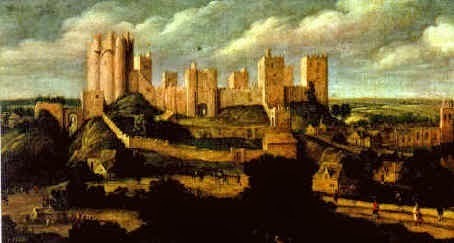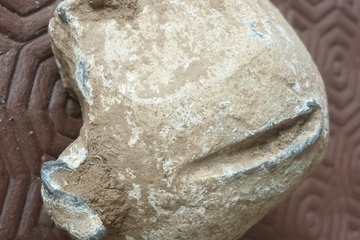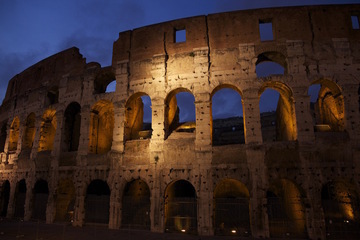MaryAnn Bernal's Blog, page 196
February 14, 2015
Game of Thrones restaurant pops up in London to celebrate season four DVD
 The Game of Thrones pop-up restaurant All Men Must Dine at the Andaz Liverpool Street, London. Photograph: Joe Pepler/Rex
The Game of Thrones pop-up restaurant All Men Must Dine at the Andaz Liverpool Street, London. Photograph: Joe Pepler/Rex All Men Must Dine, set up by HBO, serves up medieval banquet inspired by the show and food mentioned in the book
The seven deadly sins get a pretty good showing on Game of Thrones. If one character isn’t poisoning another in the name of envy or greed, they are almost certainly engaged in some lust-fuelled activity, often with a sibling. But at the Game of Thrones pop-up restaurant, in London for three days, the sin at the heart of the whole affair is unadulterated gluttony.
As one of the first guests to be ushered in to the opulent dining hall and confronted with a banquet table decorated with overflowing platters of fruit, feathers and a real-life human contortionist, one thing swiftly became clear: this whole affair was a monument to culinary excess. We were also warned there may be a couple of potential assassins or Dothraki whores in our midst, but in the world of Westeros such things are really par for the course.
The lavish, immersive restaurant, called All Men Must Dine, has been set up by HBO to mark the release of season four of the popular fantasy drama on DVD. Open from 13 to 15 February, the selected diners (winners of a Sky competition) temporarily leave behind their ordinary identities to become the elite lords, ladies and princes privy to the clandestine meeting of the Small Council in King’s Landing.
Slightly reluctantly embracing my regal new persona as Lady Hannah of Beyond The Wall, I took my seat at the table on Thursday night – easier said than done when you have to carefully avoid the limbs of the female contortionist on one side and the feathers of a taxidermied peacock on the other.
 Facebook Twitter Pinterest Game of Thrones pop-up restaurant All Men Must Dine. Photograph: Joe Pepler/Rex Nonetheless, the medieval authenticity of the banquet’s ambience was truly impeccable, helped by the flickering candlelight and group of serenading lute players – though their novelty wore off quite quickly on the sixth rendition of the Game of Thrones theme song.
Facebook Twitter Pinterest Game of Thrones pop-up restaurant All Men Must Dine. Photograph: Joe Pepler/Rex Nonetheless, the medieval authenticity of the banquet’s ambience was truly impeccable, helped by the flickering candlelight and group of serenading lute players – though their novelty wore off quite quickly on the sixth rendition of the Game of Thrones theme song.This was not to be a feast for the faint-hearted, nor one that tolerated any modern food fussiness. Vegetarians, vegans, fruitarians, those intolerant to wheat, dairy, insects or food doused in flames and dry ice were not welcome at this table.
The first of the six courses, which overall featured around 15 different dishes each symbolising a significant moment in series four, was a spiced pigeon, dried fruit and almond pie (to honour the murder of King Joffrey), accompanied by a dandelion salad and a poached veal tongue, a dish to symbolise the lies of Tyrion Lannister.
And while in my shamefully sporadic watching of Game of Thrones I’ve never had any hankering to sample what a dragon’s egg might taste like, when it is made of a buttery pastry shell filled with ham hock, prunes, apple and sage, it is actually pretty tasty. Quickly abandoning my medieval cutlery (turns out that third prong on a modern fork is quite essential) I dived in, hands first, with medieval gusto.
If the tongue was a little on the slimy side (a tad too tongue-like) everything else was fragrant and delicious. Even small loaves of spiced bread, so heavy they more closely resembled small leaden weapons than edible foodstuffs, proved worthy of the intense jaw work they required to chew.
Advertisement
As more courses followed, each handed to the diner with an explanatory handwritten scroll and several served in a flourish of smoke and fire, our silver platters began to overflow with everything from glazed eel to quail stuffed with apricots, almonds and sultanas, stuffed vine leaves and even fried locusts, which tasted like a mouthful of dust.
As we approached the fifth course, all the eating had begun to prove exhausting and by the time the whole suckling pig was brought to the table – unnervingly pierced upright on a stake and subsequently set alight in a pyre of herbs – I started to worry my usually never-ending appetite would let me down.
But, in the true spirit of Man v. Food, I persevered, spurred on by the friendly friars. Even the presence of a comedy singing ukelele duo, usually enough to ruin absolutely any occasion, proved strangely likeable, helped along by the free-flowing tankards of wine.
By the time dessert was served, we had all become so used to the unorthodox presentation of medieval delicacies that the bone filled with bone marrow custard and laced with red cherry sauce hardly caused a single raised eyebrow. Indeed, it even turned out to be a bizarre highlight of the banquet – though, as head chef Jamie Hazeel admitted afterwards, had been the course “most fraught with difficulties”.
Speaking about how he had come up with the elaborate menu, Hazeel said it had taken six weeks of research and experimentation.
“We took our inspiration from three different places,” he said. “Firstly, the image one has of medieval food, the drama of how it’s served and evocative dishes like piles of quail, a whole sucking pig and pigeon pie, that we thought were important, atmospherically to include.”
“The second source of inspiration was food that was actually mentioned in the book, such as the veal tongue which we served with oldtown mustard, which was our conception of something that was actually mentioned in the book.”
“And then the most important source of inspiration was just from different events that happened during season four of the show and celebrating those through the dishes we created,” Hazeel said.
“We are massive fans of the show, so it was a huge amount of fun.”
Hannah Ellis-Petersen
The Guardian
Published on February 14, 2015 05:47
Skeletons in 6,000-Year-Old Embrace Found in Cave
 Rossella Lorenzi Discovery News A 6,000-year-old romance has been uncovered in a Greek cave as archaeologists unearthed the skeletons of an undisturbed Neolithic couple locked in an embrace.
Rossella Lorenzi Discovery News A 6,000-year-old romance has been uncovered in a Greek cave as archaeologists unearthed the skeletons of an undisturbed Neolithic couple locked in an embrace.Found in the Alepotrypa, or foxhole, one of the Diros caves in southern Greece, the prehistoric remains were positioned curled into the fetal position, as if spooning each other. The grave also contained broken arrowheads.
Although the pair was originally found in 2014 by a team of archaeologists and speleologists led by George Papathanassopoulos, the Greek Ministry of Culture announced the results of DNA and radio carbon tests on Thursday, just in time for Valentine’s Day.
Couple Held Hands for 1,500 Years
The skeletons were dated to 3800 B.C. and DNA analysis confirmed the remains belong to a man and a woman.
“Double burials in embrace are extremely rare,” the ministry said. “The skeletons of Diros represent one of the oldest, if not the oldest, found to this date,” it added.
Discovered in 1958, the Alepotrypa Cave was used between 6000 and 3200 B.C. and served as both a settlement and a cemetery.
Around 3200 B.C., the entrance collapsed because of a severe earthquake, burying the cave inhabitants alive.
Video: The Dark Side of Valentine's Day
Excavations in recent years have yielded the remains of adults, children and even embryos.
The archaeologists also discovered a 13-foot wide crypt, paved with a unique pebble floor. The burial contained dozens of skeletons, along with pottery, beads and a dagger.
The researchers have been so far unable to establish the cause of death of the 5,800-year-old couple. But the fact that they were buried together in such a position suggests they possibly died at the same time.
Image: The 5,800-year-old couple locked in embrace. Credit: Greek Ministry of Culture.
Published on February 14, 2015 05:39
Happy Valentine’s Day: Why You Owe Your Monogamy To Saint Valentine

Happy Valentine’s Day!
If you’re coupled, and especially if you’re married in the Christian tradition, this Valentine’s Day means more than you probably realize.
Saint Valentine, the Christian figure honored on this day, died for his belief that two people in love had the right to be married.
Valentine was a bishop in Rome during the rule of Emperor Claudius II. In response to Rome’s crumbling influence and power as those formerly under the Emperor’s control began to push back against the Empire’s expansive rule, Claudius banned marriage.
The Emperor’s justification was that marriage made soldier’s weak.
Many citizens, including the Bishop Valentine, were aghast at this turn of events.
Valentine remedied this by meeting with lovers in secret and marrying them in defiance of the new edict.
The religious figure was eventually discovered and punished severely for his actions.
In 269 AD, Valentine was beaten with clubs, stoned, and beheaded for his belief in monogamous marriage.
Others say that St. Valentine only died after he tried (and failed) to convert Claudius.
Why do we exchange cards on Valentine’s Day?
It’s believed that the Roman bishop left a kind note to the jailer’s daughter ahead of his execution that he signed, “From Your Valentine.”
The idea that Valentine’s Day could be associated with something so violent may shock persons who associate it with candy and roses, but it turns out that all three men known as St. Valentine were martyred.Of the three, it’s believed that February 14th is most associated with this particular Saint Valentine. This bishop was the most popular of the group of martyrs, and most associated with lovers.Although, it’s possible that the holiday is associated with a composite of the three men.What are some important takeaways from Valentine’s Day with this in mind? There was a time when Christian monogamy was not only against the norm, but in a specific incidence, it was against the law.If you wanted to spend your life with one other person, you would have to be married in secret by a priest willing to risk his life so that you could be together.Nearly two thousand years later and things have changed quite a bit. Valentine’s Day is celebrated by monogamous lovers and happily married couples. Marriage rights are still an issue, only the persons wishing to be recognized are same-sex couples, and in some cases polygamous couples.If the most famous Saint Valentine were alive today, do you think he’d defy laws and customs to marry persecuted couples?[Image Credit: Wikimedia Commons]
Read more at inquisitor
Published on February 14, 2015 04:38
M. C. Arvanitis, writer / WORDS TOGETHER MAKE TALES: Every Writer Needs Her Fans
M. C. Arvanitis, writer / WORDS TOGETHER MAKE TALES: Every Writer Needs Her Fans: Join M. C. Arvanitis Face Book Fan Club Page http://www.facebook.com/M.C.Arvanitis Where she features her published...
Every Writer Needs Her Fans
 Join M. C. Arvanitis Face Book Fan Club Page
http://www.facebook.com/M.C.Arvanitis
Where she features her published books, or soon to be published books. Here she also reviews other writers and timely ideas to help writers along the way. She writes YA, Mid-Grade, and picture books for children.
Join M. C. Arvanitis Face Book Fan Club Page
http://www.facebook.com/M.C.Arvanitis
Where she features her published books, or soon to be published books. Here she also reviews other writers and timely ideas to help writers along the way. She writes YA, Mid-Grade, and picture books for children.

M. C. Arvanitis’s over 40 years as a teacher gives her insight into the stories young readers like. Now retired, she writes books for mid grade readers that she calls "fables." She brings forth mythical creatures such as fairies, elves, mermaids, pixies, and other strange beings
THE LEGEND OF ELPANDA PAWS, available in ebook - and print.

FORBIDDEN WINGS, A MERMAID'S STORY, available as e-books and print books.

Her third Fable, PIXIES OF THE FERNS: FERNELLA'S MAGIC. is available as an e-book, soon to be in print.

Ms Arvanitis's teen/YA historical series, HANK OF TWIN RIVERS, BOOK ONE, JOURNEY OF CHANGE, is in print & as an e-book.Two more books in the Hank series will be added to her author's list in 2015.

She is presently working on a WW2 novel, 'EMMA ROSE’S WAR', fiction for young adult and older readers, and will publish her first picture book, 'Chicken in the Oven', sometime in 2015.
Ms. Arvanitis’s books can be bought at links above or either of these links
http://www.amazon.com/M.-C.-Arvanitis/e/B007UJWLC4/ http://www.smashwords.com/profile/view/MCArvanitisWriter
You can reach her at Facebook: http://www.facebook.com/M.C.Arvanitis And leave a bit of love (like) to her page.
Every Writer Needs Her Fans
 Join M. C. Arvanitis Face Book Fan Club Page
http://www.facebook.com/M.C.Arvanitis
Where she features her published books, or soon to be published books. Here she also reviews other writers and timely ideas to help writers along the way. She writes YA, Mid-Grade, and picture books for children.
Join M. C. Arvanitis Face Book Fan Club Page
http://www.facebook.com/M.C.Arvanitis
Where she features her published books, or soon to be published books. Here she also reviews other writers and timely ideas to help writers along the way. She writes YA, Mid-Grade, and picture books for children.
M. C. Arvanitis’s over 40 years as a teacher gives her insight into the stories young readers like. Now retired, she writes books for mid grade readers that she calls "fables." She brings forth mythical creatures such as fairies, elves, mermaids, pixies, and other strange beings
THE LEGEND OF ELPANDA PAWS, available in ebook - and print.

FORBIDDEN WINGS, A MERMAID'S STORY, available as e-books and print books.

Her third Fable, PIXIES OF THE FERNS: FERNELLA'S MAGIC. is available as an e-book, soon to be in print.

Ms Arvanitis's teen/YA historical series, HANK OF TWIN RIVERS, BOOK ONE, JOURNEY OF CHANGE, is in print & as an e-book.Two more books in the Hank series will be added to her author's list in 2015.

She is presently working on a WW2 novel, 'EMMA ROSE’S WAR', fiction for young adult and older readers, and will publish her first picture book, 'Chicken in the Oven', sometime in 2015.

Ms. Arvanitis’s books can be bought at links above or either of these links
http://www.amazon.com/M.-C.-Arvanitis/e/B007UJWLC4/ http://www.smashwords.com/profile/view/MCArvanitisWriter
You can reach her at Facebook: http://www.facebook.com/M.C.Arvanitis And leave a bit of love (like) to her page.

Published on February 14, 2015 04:29
History Trivia - Julius Caesar was made dictator of Rome for life
February 14

44 BC, Julius Caesar was made dictator of Rome for life, which turned out to be one month and a day.

1400 Britain's deposed Richard II was murdered in Pontefract Castle in Yorkshire.

1556 Thomas Cranmer, leader of the English Reformation and Archbishop of Canterbury during the reigns of Henry VIII and Edward VI, was declared a heretic when staunch Catholic Mary I became Queen.

44 BC, Julius Caesar was made dictator of Rome for life, which turned out to be one month and a day.

1400 Britain's deposed Richard II was murdered in Pontefract Castle in Yorkshire.

1556 Thomas Cranmer, leader of the English Reformation and Archbishop of Canterbury during the reigns of Henry VIII and Edward VI, was declared a heretic when staunch Catholic Mary I became Queen.
Published on February 14, 2015 02:00
February 13, 2015
Lost and Found: Oldest Cannonball in England Rediscovered
by Tia Ghose
Live Science

 Found at the site of the Battle of Northampton, this lead ball is thought to be the oldest surviving cannonball in England.
Found at the site of the Battle of Northampton, this lead ball is thought to be the oldest surviving cannonball in England.
Credit : Northampton Battlefields Society View full size image
: Northampton Battlefields Society View full size image
The oldest surviving cannonball in England has been rediscovered on a medieval battlefield.
The cannonball, which was lost for several years, was likely used in the Battle of Northampton in 1460, one of the battles in the decades-long Wars of the Roses. The giant ball has two large dents from a few bounces, as well as a gouge mark that contains fragments of sand from the area.
Most historians believe the cannon was first developed in China, and was used in war throughout the Middle East before making its way to Europe. The first English illustration of a cannon dates to 1327, and the "crakys of war," as cannonballs were called. Thought to be a gunpowder-based weapon, the cannon was first mentioned that same year in accounts of the Battle of Stanhope Park, one of the battles in the First War of Scottish Independence, according to the "Oxford Encyclopedia of Medieval Warfare and Military Technology" (Oxford University Press, 2010). [10 Epic Battles That Changed History]
East before making its way to Europe. The first English illustration of a cannon dates to 1327, and the "crakys of war," as cannonballs were called. Thought to be a gunpowder-based weapon, the cannon was first mentioned that same year in accounts of the Battle of Stanhope Park, one of the battles in the First War of Scottish Independence, according to the "Oxford Encyclopedia of Medieval Warfare and Military Technology" (Oxford University Press, 2010). [10 Epic Battles That Changed History]
The Battle of Northampton was fought in 1460 as part of a 32-year struggle over the English throne between two rival houses , York and Lancaster. The drawn-out feud finally ended when Henry Tudor, of the House of Lancaster, defeated King Richard III at the Battle of Bosworth Field.
, York and Lancaster. The drawn-out feud finally ended when Henry Tudor, of the House of Lancaster, defeated King Richard III at the Battle of Bosworth Field.
The massive cannonball was first discovered several years ago, but was lost until Glenn Foard, an archaeologist at the University of Huddersfield, in England, rediscovered it last year. Foard performed a thorough analysis of the ball, which sustained major impact damage.
of Huddersfield, in England, rediscovered it last year. Foard performed a thorough analysis of the ball, which sustained major impact damage.
"It is highly likely that the projectile was fired during the battle in 1460," Foard said in a statement from the Northampton Battlefield Society.
is highly likely that the projectile was fired during the battle in 1460," Foard said in a statement from the Northampton Battlefield Society.
The cannonball has been deformed, likely by two major impacts. The cannonball also had a gouge filled with iron and sandstone from the area, likely picked up as it bounced around the battlefield. The cannonball showed more damage possibly from hitting a tree.
Historical accounts suggest that rain prevented the cannons of the Lancastrian forces from firing. So researchers suspect the cannonball may have been fired by the Yorkists.
The ancient battlefield is rich with other archaeological treasures. The site also houses the remains of a Roman villa, finds from the Stone Age and the possible traces of ancient Neolithic pathways.
Live Science

 Found at the site of the Battle of Northampton, this lead ball is thought to be the oldest surviving cannonball in England.
Found at the site of the Battle of Northampton, this lead ball is thought to be the oldest surviving cannonball in England.Credit
 : Northampton Battlefields Society View full size image
: Northampton Battlefields Society View full size imageThe oldest surviving cannonball in England has been rediscovered on a medieval battlefield.
The cannonball, which was lost for several years, was likely used in the Battle of Northampton in 1460, one of the battles in the decades-long Wars of the Roses. The giant ball has two large dents from a few bounces, as well as a gouge mark that contains fragments of sand from the area.
Most historians believe the cannon was first developed in China, and was used in war throughout the Middle
 East before making its way to Europe. The first English illustration of a cannon dates to 1327, and the "crakys of war," as cannonballs were called. Thought to be a gunpowder-based weapon, the cannon was first mentioned that same year in accounts of the Battle of Stanhope Park, one of the battles in the First War of Scottish Independence, according to the "Oxford Encyclopedia of Medieval Warfare and Military Technology" (Oxford University Press, 2010). [10 Epic Battles That Changed History]
East before making its way to Europe. The first English illustration of a cannon dates to 1327, and the "crakys of war," as cannonballs were called. Thought to be a gunpowder-based weapon, the cannon was first mentioned that same year in accounts of the Battle of Stanhope Park, one of the battles in the First War of Scottish Independence, according to the "Oxford Encyclopedia of Medieval Warfare and Military Technology" (Oxford University Press, 2010). [10 Epic Battles That Changed History] The Battle of Northampton was fought in 1460 as part of a 32-year struggle over the English throne between two rival houses
 , York and Lancaster. The drawn-out feud finally ended when Henry Tudor, of the House of Lancaster, defeated King Richard III at the Battle of Bosworth Field.
, York and Lancaster. The drawn-out feud finally ended when Henry Tudor, of the House of Lancaster, defeated King Richard III at the Battle of Bosworth Field.The massive cannonball was first discovered several years ago, but was lost until Glenn Foard, an archaeologist at the University
 of Huddersfield, in England, rediscovered it last year. Foard performed a thorough analysis of the ball, which sustained major impact damage.
of Huddersfield, in England, rediscovered it last year. Foard performed a thorough analysis of the ball, which sustained major impact damage."It
 is highly likely that the projectile was fired during the battle in 1460," Foard said in a statement from the Northampton Battlefield Society.
is highly likely that the projectile was fired during the battle in 1460," Foard said in a statement from the Northampton Battlefield Society.The cannonball has been deformed, likely by two major impacts. The cannonball also had a gouge filled with iron and sandstone from the area, likely picked up as it bounced around the battlefield. The cannonball showed more damage possibly from hitting a tree.
Historical accounts suggest that rain prevented the cannons of the Lancastrian forces from firing. So researchers suspect the cannonball may have been fired by the Yorkists.
The ancient battlefield is rich with other archaeological treasures. The site also houses the remains of a Roman villa, finds from the Stone Age and the possible traces of ancient Neolithic pathways.
Published on February 13, 2015 06:39
British scientists say they've found wounds that likely killed Richard III
 Fox News
Fox NewsBritish pathologists investigating the skeleton of Richard III say they may have located the wound that killed him 530 years ago.
Scientists at the University of Leicester told Sky News that they discovered a severe injury at the base of the late king's skull, which they say could have come from a sword, bill, or halberd. The latter two weapons consist of a long pole with an axe head or hooked blade on the end.
"Using modern forensic examination, we have discovered that Richard's skeleton sustained 11 wounds at or near the time of his death," Professor Sarah Hainsworth told Sky, "nine of them to the skull, which were clearly inflicted in battle."Hainsworth said the other two injuries were located on the skeleton's pelvis and a rib, adding "The injuries to the head suggest he had either removed or lost his helmet."
The exact whereabouts of Richard III's body remained a mystery until 2012, when archaeologists discovered his remains under a parking lot in Leicester. The last king of the House of York, Richard was killed in 1485 at the Battle of Bosworth Field, not far from the city, and buried in the Greyfriars Church. He was the last English monarch killed in battle, and his death brought about the end of the Wars of the Roses.
The pathologists used whole-body CT scans and micro-CT imaging to examine the bones. Professor Guy Rutty called the discovery of the injuries a "eureka moment [that] we will all remember."
Published on February 13, 2015 06:24
History Trivia - Catherine Howard, the fifth wife of Henry VIII of England, executed
February 13,

1542 Catherine Howard, the fifth wife of Henry VIII of England, was executed for adultery.

1633 Galileo Galilei arrived in Rome for his trial before the Inquisition.

1692 Massacre of Glencoe Scotland where 38 members of the MacDonald clan were murdered by soldiers of the Campbell clan for not pledging allegiance to William of Orange.

1542 Catherine Howard, the fifth wife of Henry VIII of England, was executed for adultery.

1633 Galileo Galilei arrived in Rome for his trial before the Inquisition.

1692 Massacre of Glencoe Scotland where 38 members of the MacDonald clan were murdered by soldiers of the Campbell clan for not pledging allegiance to William of Orange.
Published on February 13, 2015 02:30
February 12, 2015
Engineering Marvels: Series Explores Mysteries of Ancient Buildings
Tanya Lewis,
Live Science

 The Colosseum in Rome, one of the subjects of a new NOVA series, was home to bloody spectacles and wild animal fights.
The Colosseum in Rome, one of the subjects of a new NOVA series, was home to bloody spectacles and wild animal fights.
Credit: Providence Pictures View full size image
How did the Romans release wild animals into their mighty Colosseum? How did the massive Hagia Sophia cathedral in Istanbul withstand centuries of earthquakes? And how did a desert people carve elaborate tombs in rocky cliffs in Jordan?
These are some of the questions that a new NOVA series on the mysteries of ancient buildings seeks to answer. The three-part series, called "Building Wonders of the World," premieres tonight (Feb. 11) at 9 p.m. ET (8 p.m. CT).
"We are contributing to the scholarly and scientific investigation of what the buildings meant to people, and how they actually built them," said series producer Gary Glassman, of Providence Pictures. [In Photos: Amazing Ruins of the Ancient World]
The buildings are like "snapshots in stone," Glassman told Live Science: "They are what the culture at that moment wanted to project."
Death in the Colosseum
Perhaps the most iconic symbol of the Roman Empire, the Colosseum was built in just 10 years from A.D. 70 to A.D. 80, during the reign of the emperor Vespasian and his successor, Titus. The massive structure was host to deadly gladiator fights, wild animal maulings and epic sea battles, according to historical records.
The first episode of the NOVA series explores the mystery of how wild lions and elephants "magically" appeared in the arena, where they were pitted against each other or human prisoners, as ancient texts describe. To find out, a team of archaeologists and engineers used ancient Roman building methods to create a 25-foot-tall (7.6 meters) lifting machine and trap-door system, and used it to deliver a wolf into the Colosseum's arena.
"We released a wolf into the Colosseum for the first time in 1,500 years," Glassman said.
Ancient texts also depict elaborate mock naval battles in which ships were sunk and thousands of people – mostly slaves and prisoners – met their deaths. To find out how the Romans may have flooded the Colosseum to stage these battles, the researchers traced a system of aqueducts that lead to the arena. [Photos: Gladiators of the Roman Empire]
Lost city of stone
The second episode of the new series explores how the city of Petra, in Jordan, came to be built.
"The people who built Petra, known as the Nabataeans, had probably the greatest unknown kingdom that ever existed," Glassman said. "In a 200-year period, they went from being nomadic tradesmen to building a city in the middle of the desert that rivaled the major cities of the Mediterranean world."
 [image error]
[image error]
 The Monastary has some of the most complicated architecture in all of Petra, relying heavily on Hellenistic and Greco-Roman influences for its style.
The Monastary has some of the most complicated architecture in all of Petra, relying heavily on Hellenistic and Greco-Roman influences for its style.
Credit: Providence PicturesView full size imagePetra was a major stop on the incense trade route, and the Nabataeans brought in water from everywhere within a 20-mile (32 kilometers) radius via a system of channels, dams and reservoirs. Not only did they have enough water to supply a city of 30,000 people, but they had lavish fountains and pools as well, Glassman said. One of the scholars interviewed on the show called it "the Las Vegas of the ancient world."
But the Nabataeans' most impressive feat was a system of templelike tombs carved into the nearby cliff faces. The tombs were "twice the size of Mount Rushmore," and it was always a mystery how they built them without the aid of scaffolding, Glassman said.
NOVA hired a team of stonemasons, a geoscientist and a restoration expert to create their own tomb in a cliff face. The Nabataeans' secret, Glassman said, was starting from the top of the tomb and working their way down, using debris from the sculpting to make a ramp to other areas.
Istanbul's domed masterpiece
The show's final episode focuses on the Hagia Sophia, a massive stone cathedral in modern-day Istanbul, Turkey, that became a mosque and is now a museum. Built in seven years and completed in 537 A.D., "it was the biggest building on Earth except for the pyramids for over 1,000 years," Glassman said.
 [image error]
[image error]
 Even after 1500 years the Hagia Sophia still stands proudly in the historical heart of Istanbul.
Even after 1500 years the Hagia Sophia still stands proudly in the historical heart of Istanbul.
Credit: Providence PicturesView full size imageHow has the giant, domed relic withstood 1,500 years of earthquakes that destroyed all the buildings around it? NOVA hired a team of builders to construct a scale model of the Hagia Sophia on a shake table that simulates quakes. The model withstood a lot of shaking before it finally collapsed.
When the real Hagia Sophia was built, people were aware of earthquakes, but they kept trying to build walls that were thicker and more massive, Glassman said. By contrast, the engineers who designed the Hagia Sophia — who had never built anything before — made it light and flexible, he said. This strategy became the foundation of modern seismic engineering.
Through these investigations, the new TV series explores what these buildings meant to the cultures that built them, Glassman said. "If intelligent life from another planet were to come to Earth, these are some of the buildings we would want to bring them to [in order] to represent the height of our achievements."
Live Science

 The Colosseum in Rome, one of the subjects of a new NOVA series, was home to bloody spectacles and wild animal fights.
The Colosseum in Rome, one of the subjects of a new NOVA series, was home to bloody spectacles and wild animal fights.Credit: Providence Pictures View full size image
How did the Romans release wild animals into their mighty Colosseum? How did the massive Hagia Sophia cathedral in Istanbul withstand centuries of earthquakes? And how did a desert people carve elaborate tombs in rocky cliffs in Jordan?
These are some of the questions that a new NOVA series on the mysteries of ancient buildings seeks to answer. The three-part series, called "Building Wonders of the World," premieres tonight (Feb. 11) at 9 p.m. ET (8 p.m. CT).
"We are contributing to the scholarly and scientific investigation of what the buildings meant to people, and how they actually built them," said series producer Gary Glassman, of Providence Pictures. [In Photos: Amazing Ruins of the Ancient World]
The buildings are like "snapshots in stone," Glassman told Live Science: "They are what the culture at that moment wanted to project."
Death in the Colosseum
Perhaps the most iconic symbol of the Roman Empire, the Colosseum was built in just 10 years from A.D. 70 to A.D. 80, during the reign of the emperor Vespasian and his successor, Titus. The massive structure was host to deadly gladiator fights, wild animal maulings and epic sea battles, according to historical records.
The first episode of the NOVA series explores the mystery of how wild lions and elephants "magically" appeared in the arena, where they were pitted against each other or human prisoners, as ancient texts describe. To find out, a team of archaeologists and engineers used ancient Roman building methods to create a 25-foot-tall (7.6 meters) lifting machine and trap-door system, and used it to deliver a wolf into the Colosseum's arena.
"We released a wolf into the Colosseum for the first time in 1,500 years," Glassman said.
Ancient texts also depict elaborate mock naval battles in which ships were sunk and thousands of people – mostly slaves and prisoners – met their deaths. To find out how the Romans may have flooded the Colosseum to stage these battles, the researchers traced a system of aqueducts that lead to the arena. [Photos: Gladiators of the Roman Empire]
Lost city of stone
The second episode of the new series explores how the city of Petra, in Jordan, came to be built.
"The people who built Petra, known as the Nabataeans, had probably the greatest unknown kingdom that ever existed," Glassman said. "In a 200-year period, they went from being nomadic tradesmen to building a city in the middle of the desert that rivaled the major cities of the Mediterranean world."
 [image error]
[image error]
 The Monastary has some of the most complicated architecture in all of Petra, relying heavily on Hellenistic and Greco-Roman influences for its style.
The Monastary has some of the most complicated architecture in all of Petra, relying heavily on Hellenistic and Greco-Roman influences for its style. Credit: Providence PicturesView full size imagePetra was a major stop on the incense trade route, and the Nabataeans brought in water from everywhere within a 20-mile (32 kilometers) radius via a system of channels, dams and reservoirs. Not only did they have enough water to supply a city of 30,000 people, but they had lavish fountains and pools as well, Glassman said. One of the scholars interviewed on the show called it "the Las Vegas of the ancient world."
But the Nabataeans' most impressive feat was a system of templelike tombs carved into the nearby cliff faces. The tombs were "twice the size of Mount Rushmore," and it was always a mystery how they built them without the aid of scaffolding, Glassman said.
NOVA hired a team of stonemasons, a geoscientist and a restoration expert to create their own tomb in a cliff face. The Nabataeans' secret, Glassman said, was starting from the top of the tomb and working their way down, using debris from the sculpting to make a ramp to other areas.
Istanbul's domed masterpiece
The show's final episode focuses on the Hagia Sophia, a massive stone cathedral in modern-day Istanbul, Turkey, that became a mosque and is now a museum. Built in seven years and completed in 537 A.D., "it was the biggest building on Earth except for the pyramids for over 1,000 years," Glassman said.
 [image error]
[image error]
 Even after 1500 years the Hagia Sophia still stands proudly in the historical heart of Istanbul.
Even after 1500 years the Hagia Sophia still stands proudly in the historical heart of Istanbul. Credit: Providence PicturesView full size imageHow has the giant, domed relic withstood 1,500 years of earthquakes that destroyed all the buildings around it? NOVA hired a team of builders to construct a scale model of the Hagia Sophia on a shake table that simulates quakes. The model withstood a lot of shaking before it finally collapsed.
When the real Hagia Sophia was built, people were aware of earthquakes, but they kept trying to build walls that were thicker and more massive, Glassman said. By contrast, the engineers who designed the Hagia Sophia — who had never built anything before — made it light and flexible, he said. This strategy became the foundation of modern seismic engineering.
Through these investigations, the new TV series explores what these buildings meant to the cultures that built them, Glassman said. "If intelligent life from another planet were to come to Earth, these are some of the buildings we would want to bring them to [in order] to represent the height of our achievements."
Published on February 12, 2015 06:31
Oldest Twin Remains Found in Siberia

Rossella Lorenzi
Discovery News
A team of Canadian and Russian researchers investigating an early Neolithic cemetery in Siberia have identified the world’s oldest set of human twins, buried with their young mother.
The skeleton of the woman was exhumed in 1997 from a hunter-gatherer cemetery in south-eastern Siberia. Found with 15 marmot teeth — decorative accessories which were probably attached to clothing — the remains were photographed and labelled, but were not investigated by anthropologists.
Now Angela Lieverse, a bioarchaeologist at the University of Saskatchewan, Canada, and colleagues Andrzej Weber from the University of Alberta, Canada, and Vladimir Bazaliiskii from Irkutsk University, Russia, have examined the skeleton and found remains of twin fetuses nestled between the pelvis and upper legs.
Ancient Images of a Mother Giving Birth Found
The twins, about 36 to 40 weeks old, probably suffocated during their mother’s troubled labor nearly 8,000 years ago.
“This is not only one of the oldest archaeologically documented cases of death during childbirth, but also the earliest confirmed set of human twins in the world,” Lieverse said.
Radiocarbon dating on small samples of the mother’s and twins’ bones confirmed the skeletal remains are about 7,700 years old.
Death from childbirth was quite common in prehistoric and pre-modern societies, but it has rarely been documented.
Video: How Twins Advance Science
This could be because women and their children were rarely buried together or simply because the delicate remains of the unborn didn’t survive.
Evidence of twins is exceptionally rare.
“They are basically invisible from the archaeological record,” Lieverse told Discovery News.
She noted that only one other case of confirmed human twins has been reported in the archaeological literature. The case involved 400-year-old twin remains, aged about 24 week gestation, which were excavated from a burial in South Dakota. However, death for the twins and their mother did not appear to have resulted from complications related to premature childbirth.
Twins Born 87 Days Apart
According to Lieverse, the skeleton of the Siberian woman, who lived with her Neolithic community near the shore of Lake Baikal, the world’s deepest, tells “a compelling story and very personal window into life—and death—almost 8,000 years ago.”
The researcher estimates the woman was in her early twenties when she went into labor. She likely didn’t know she was having twins.
The location of the fetal remains suggests the first baby was breech — coming out feet first — a dangerous condition complicated by the presence of the twin.
While the first baby was partially delivered, at some point labor was obstructed, either by interlocked twins, head entrapment or some other condition such as the infant’s arms beside or behind its head.
Supermom Primates Raise Twins
There was nothing her community could do for her.
“Without the skills, experience and technology of modern medical practictioners, this case of dystocia [obstructed labor] would have been a virtual death sentence for all three individuals,” Lieverse and colleagues wrote in the current issue of the journal Antiquity.
Obstructed labor accounted for as many as 70 percent of maternal deaths worldwide even in the late 20th century.
In the end, the mother would have succumbed to infection, bleeding or exhaustion, taking her suffocated twins with her to the grave.
Image: The skeleton of the mother in her grave pit. The small bones in her pelvic-abdominal area and between her thighs are the remains of the infants. Credit: Angela Lieverse.
Published on February 12, 2015 06:22



